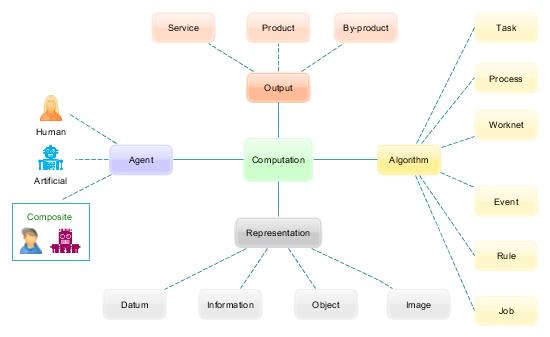Enterprise Computation
Computation has become the main operational activity of most 21st century enterprises, and in many cases the only one. In other cases, it complements or is being complemented by physical and chemical activities.
The enterprise engineering framework (EEF) is a digital framework that takes into consideration only the computational activities of the enterprise. Other types of activities are well supported by non-digital frameworks and architectures, many of which date back over a thousand years.
Computation is a purposeful activity performed by human (brains), artificial (computers), or composite agents (units), and produces value in forms of products and services delivered to the ultimate customer.
Artificial (software) agents perform computation using explicit knowledge and algorithms, whereas human agents may, in addition, use tacit knowledge, practical and general intelligence, intuition, and expertise. While today's computers demonstrate phenomenal performance (productivity and the ability to learn input-output relations and recognize patterns), humans, who are hardwired to generalize and empathize, use their understanding of motivation and the principles behind complex social and natural phenomena to perform advanced scientific, engineering, and artistic computations.
Figure 2.1. Enterprise Computation.
Online Resources
- Unit Oriented Architecture
- Enterprise Transformation
- Defining Enterprise Architecture: The Systems Are the Enterprise by John A. Zachman
- Defining Enterprise Architecture: Misunderstandings by John A. Zachman
- Intro to EA: The Paradigm Problem by John A. Zachman
- Software Architecture Is Not Building Architecture by Bex Huff
- Cooperation vs Collaboration
- A Better Path to Enterprise Architectures by Roger Sessions
- What to Think About Machines That Think?
- What Will Change Everything?
Key Points
The Enterprise was never holistically engineered, according to John A. Zachman.
The EEF is a lightweight enterprise reengineering framework focused on computational activities and the digital architecture of the enterprise. The physical architecture, which supports physical/chemical activities of the enterprise, may complement the digital architecture, but it is outside the scope of the EEF.
The main enterprise building blocks are individual human agents, individual software agents, and composite agents (units). The other parts are tools, boundary constructs, platforms, and infrastructure.
Two types of structures define the enterprise. The enterprise itself is a collection (flat network) of units. Although the network is flat, there exist asymmetric hierarchical relations (directing/reporting) between the units. A unit is a collection (flat network) of individual agents (both human and artificial). The individual agents may also have hierarchical relations.
At the enterprise level, computational activities of units are coordinated using an expectation-oriented style described by the event-process-event pattern. At the unit level, computational activities of individual agents can be coordinated using either the expectation-oriented or the command-and-control style described by the event-task-event pattern.
At the enterprise level, units communicate asynchronously; at the unit level, either asynchronously or synchronously, depending on the coordination style.
The EEF recommends the top-down approach to enterprise transformation. It begins with the social transformation that streamlines the human architecture of the enterprise and partitions it into the collection of executive and functional units. The second stage is the systemic transformation that creates units' boundary constructs and enables effective enterprise-level communication and coordination. The last stage is the unit transformation, where each unit can be reengineered at its own pace.